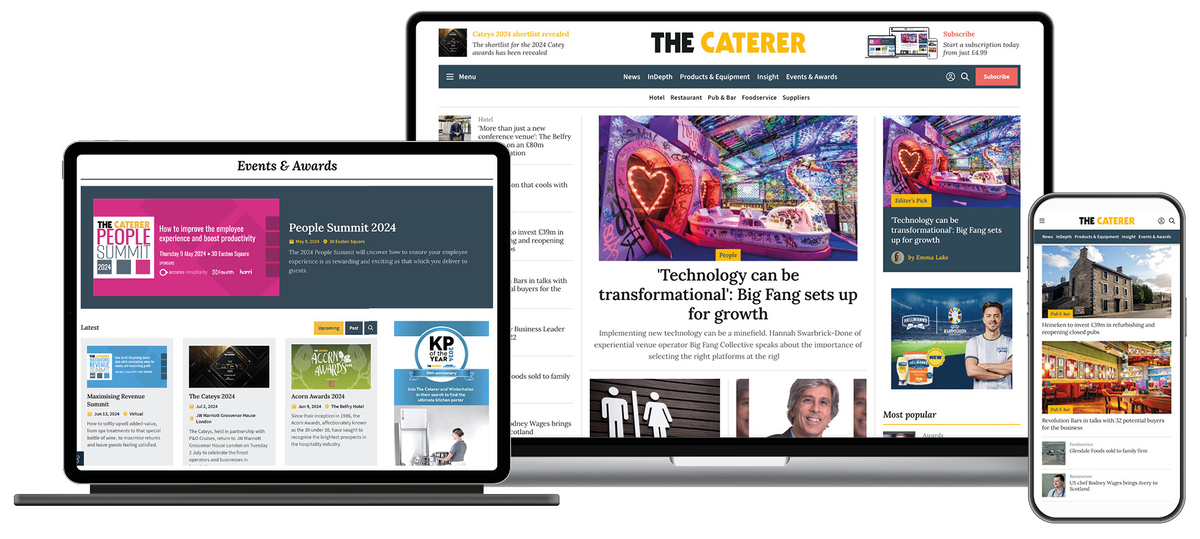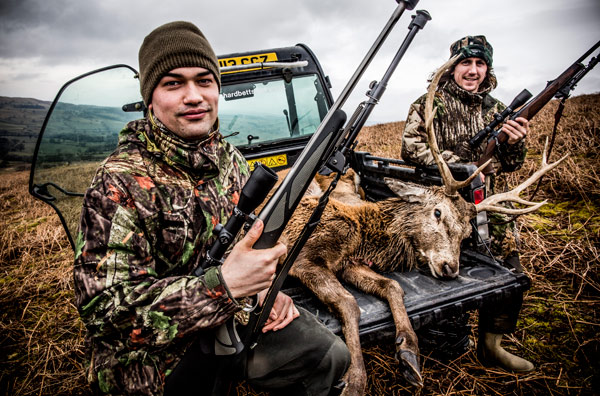From stalk to plate: a deer shoot with Luke Selby and Josh Bingham
It is easy to be disconnected from the origins of meat when it so often arrives in the kitchen butchered, filleted and portioned.
So for Luke Selby, head chef of Ollie Dabbous and Hedonism Wines' new Hide restaurant in Piccadilly, London, and his senior sous chef Josh Bingham, taking part in a deer shoot was a truly eye-opening experience.
The opportunity came about when they were invited to Cumbria by Udale Speciality Foods as part of Selby's prize for winning last year's Roux Scholarship. Udale supplies all kinds of meat, game and poultry, specialising in salt-aged meats.
The business's co-owner, Neil Udale, believes it is important for chefs to understand the field-to-plate process, to help them appreciate the ingredients they work with. "I wanted to offer something different as a prize, rather than provide a cut of meat or a goody bag," he says. "This would be an experience they would remember.
"Taking part in a shoot helps chefs gain a level of understanding about where meat comes from and conservation. People may think of shooting as a fun sport, but when it comes to deer, there's a certain amount of culling that needs to be done in order to conserve the species.
Much of the meat supplied by Udale is dry-aged in a Himalayan salt chamber for varying lengths of time to intensify the flavour without the bacterial growth often associated with naturally dry-aged meat. Beef with a good fat covering can be aged for up to 100 days, with very little spoilage. Game such as venison, which is very lean, should be aged in the chamber for up to 10 days only.
Selby and Bingham's trip to Cumbria began one Friday evening in early March, when they met up for supper in the Barbon Inn in the village of Carnforth with Udale and keen deer-stalker Stephen Rogers to discuss the following day's shoot. The pair were given a crash course in the basics of shooting a rifle at Rogers' home before they retired for the night.
Up early the next morning for some shooting practice, the chefs then drove some 45 minutes into the heart of the Lakeland fells, where they met up with deer-stalkers James and Dave, who asked for their surnames to remain anonymous.
The visibility was initially poor, but once the rain and mist cleared, James and Dave started to spot movement from a herd of red deer. They used binoculars, but also had an inbuilt sense of where to look and where the deer were likely to be.
As Selby and Dave approached the deer, they started to crouch lower and lower, until they were crawling on their elbows and knees. âWhen we got in the right position, about 100 yards away â" it took 20 minutes â" I was able to line up the perfect shot,â says Selby.
The chefs were told to aim for the deerâs chest â" the animalâs centre of mass. Deer have small heads, so shots to this area should be avoided, as a bullet could shatter the jaw or nose, causing pain to the animal.
Meanwhile, Binghamâs group spent 45 minutes climbing a hill before surrounding a deer. The animal spotted the trio and was about to run off when James made a barking sound to tell Bingham to take a shot straight away. âI was told that you have only three seconds before the deer bolts,â says Bingham. âI wasnât nervous beforehand, but afterwards I had an adrenaline rush. It was a really strange feeling, killing an animal.â
The shot deer were bled and gutted (gralloched) on the hillside, as it makes the carcass lighter and therefore easier to transport back to the vehicle. The guts were left behind for other animals to eat.
âItâs a strange feeling to touch a deer when it is still warm,â says Selby. âIt gives you a connection to the animal that you donât get when the meat comes into the kitchen ready prepped.â
Back at base at Rogersâ home, Selby and Bingham prepared a venison dish, using meat that had already been dry-aged by Udale (see recipe overleaf). Although on this occasion he didnât, Selby will often wrap venison in bacon to protect the lean meat. âI then sometimes poach it lightly and finish it in a pan with foaming butter,â he says. âI will always pair venison with a well-flavoured fruit, such as blackberries, and a classic vegetable, such as Brussels sprouts.â
For Selby and Bingham, the Cumbria trip has had a significant impact on their approach to handling meat. Selby says: âIt definitely made me think about where our food comes from and the link between nature and what we eat. âDeer are beautiful creatures and it is now even more important that my chefs treat the produce and ingredients we receive in the kitchen with the full respect they deserve.
âI learned so much on the stalk about deer and it was amazing how knowledgeable and passionate James and Dave were about them. The season is drawing to an end [at the end of March], but I will definitely put venison on the menu at Hide at the start of next season.â
â- Hide is due to open at 85 Piccadilly, London, in April
Roasted venison with a walnut crumb, chestnuts, bacon, parsnip purée, butternut squash, caramelised carrots and a red wine sauce
Serves 6
For the venison
1 onion, chopped
1 celery stick, chopped
1 carrot, chopped
500ml red wine
2g juniper berries
2g thyme
1 long saddle venison (red deer)
50ml oil
20ml red wine vinegar
70ml venison sauce to glaze (see below)
To make the marinade, bring the onion, celery, carrot, red wine, juniper and thyme to the boil and chill immediately. Bone the venison and trim off any sinew and fat. Place the loin in the cool marinade for at least an hour.
Cook at 52°C for 30 minutes. Heat the oil in a pan large enough to take the venison, then sear the two loins on all sides. Deglaze with the vinegar and a little venison sauce. Rest the venison.
For the sauce (makes around 400ml)
60g butter
1kg venison bones and trimmings
1 onion, chopped
1 celery stick, chopped
1 carrot, chopped
500ml port
500ml red wine
20g red wine vinegar
500ml veal stock
250ml white chicken stock
2g thyme
2g juniper
1 bay leaf
200g blackberries
20g redcurrant jelly
10g 72% dark chocolate
50ml gin
Brown half the butter and caramelise the venison bones, trimmings and vegetables in it. Deglaze the pan with the port, vinegar and red wine. Reduce until syrupy and add the stock.
Simmer until reduced by two-thirds, skimming constantly. Pass, reduce to a light demi-glaze consistency and infuse the fresh herbs, spices, blackberries and redcurrant jelly in the sauce. Pass again, adjust the seasoning and finish with the dark chocolate and gin. Use 70ml to glaze the venison.
Monté the rest of the sauce with the remaining butter and serve separately to accompany the plated dish.
For the parsnip purée (enough for 12)
400g parsnip, diced
60g butter
150g milk
4g salt
Cook the parsnip sous vide in boiling water with the rest of the ingredients until tender. After about 20 minutes, blend and pass. Keep warm.
Baked butternut squash
1 whole butternut squash
100g beurre noisette
Make a hole in the hollow of the butternut squash. Pour in the hot beurre noisette and bake at 180°C for 90 minutes. Rest. Slice in half and scoop into 10g pieces, reserve and keep warm.
For the roasted baby carrots
200g baby carrots, peeled and trimmed
50g butter
2g salt
4g thyme
2g garlic, sliced
Cook the carrots in foaming butter until just soft. Season, add the herbs and leave to rest.
For the roasted chestnuts and bacon
200g double-smoked streaky bacon
50g butter
250g whole cooked chestnuts
Dice the bacon into thick lardons. Caramelise until golden in the butter and then add the chestnuts. Continue cooking until evenly coloured.
Walnut crumb
250g walnuts
4g salt
4g black pepper
Toast the walnuts until a warm golden colour. Blend coarsely to a powder. Season and reserve.
To serve
Swipe the parsnip purée on the plate. Dress with the hot carrots, butternut squash pieces, caramelised bacon and chestnuts, following the curve of the purée. Roll the glazed venison in the walnut crumb and carve. Arrange the sliced venison in the middle and garnish with red chicory leaves. Serve the sauce on the side.




















